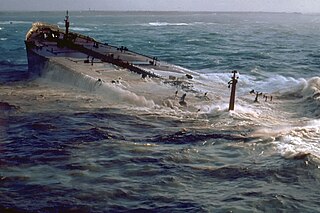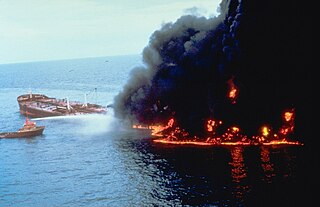Related Research Articles

Exxon Valdez was an oil tanker that gained notoriety after running aground in Prince William Sound, spilling her cargo of crude oil into the sea. On 24 March 1989, while owned by the former Exxon Shipping Company, captained by Joseph Hazelwood and First Mate James Kunkel, and bound for Long Beach, California, the vessel ran aground on the Bligh Reef, resulting in the second largest oil spill in United States history. The size of the spill is estimated to have been 40,900 to 120,000 m3. In 1989, the Exxon Valdez oil spill was listed as the 54th-largest spill in history.
This is a list of aviation-related events from 1984.

Amoco Cadiz was a VLCC owned by Amoco Transport Corp and transporting crude oil for Shell Oil. Operating under the Liberian flag, she ran aground on 16 March 1978 on Portsall Rocks, 2 km (1.2 mi) from the coast of Brittany, France. Ultimately she split in three and sank, resulting in the largest oil spill of its kind in history to that date.

USCGC Mesquite (WAGL/WLB-305) was the lead ship in the Mesquite class of seagoing buoy tenders operated by the United States Coast Guard. She served in the Pacific during World War II, and spent the rest of her Coast Guard career in the Great Lakes. She ran aground and was wrecked in December 1989 off the Keweenaw Peninsula in Lake Superior. She was scuttled nearby as a recreational diving attraction.

Kharg or Khark Island is a continental island of Iran in the Persian Gulf. The island is 25 km (16 mi) off the coast of Iran and 483 km (300 mi) northwest of the Strait of Hormuz. Its total area is 20 km2 (7.7 sq mi). Administered by the adjacent coastal Bushehr Province, Khark Island provides a sea port for the export of oil and extends Iranian territorial sea claims into the Persian Gulf oil fields. Located on Khark Island is Khark, the only city in the Khark District.
SS Atlantic Empress was a Greek oil tanker that in 1979 collided with the oil tanker Aegean Captain in the Caribbean, and eventually sank, having created the fifth largest oil spill on record and the largest ship-based spill having spilled 287,000 metric tonnes of crude oil into the Caribbean Sea. It was built at the Odense Staalskibsværft shipyard in Odense, Denmark, and launched on 16 February 1974.

The USS Manatee (AO-58)—the second vessel of the United States Navy to bear the name—was a Cimarron-class fleet replenishment oiler named for a river in Florida. Cimarron-class oilers were named after American rivers in the southern United States.

The Prestige oil spill occurred off the coast of Galicia, Spain in November 2002, caused by the sinking of the 26-year-old, structurally deficient oil tanker MV Prestige, carrying 77,000 tonnes of heavy fuel oil. During a storm, it burst a tank on 13 November, and French, Spanish, and Portuguese governments refused to allow the ship to dock. The vessel subsequently sank on 19 November, about 210 kilometres (130 mi) from the coast of Galicia. It is estimated that it spilled 60,000 tonnes or a volume of 67,000 3 (17.8 million US gal) of heavy fuel oil.

IRIS Kharg was a modified Ol-class fleet replenishment oiler of the Islamic Republic of Iran Navy, named after Kharg Island. Built by Swan Hunter in the United Kingdom and launched in 1977, it was delivered to Iran in 1984. Kharg was Iran's largest naval vessel based on tonnage until the commissioning of IRIS Makran in early 2021.
The Venpet–Venoil collision was a maritime accident involving sister supertankers; the Liberian-registered Venoil and Venpet, in dense fog off the coast of South Africa on 16 December 1977. The tankers were travelling in opposite directions; the Venoil fully laden with over 250,000 tonnes of crude oil bound for Halifax, Canada, and the Venpet, travelling in ballast, headed for Kharg Island, Iran. The Venoil ploughed into the Venpet, eventually leading to the spilling of approximately 26,600–30,500 tonnes of crude oil. The tankers were sister ships owned and operated by Bethlehem Steel Corporation. Both ships were manned by Taiwanese crews.

The Amoco Cadiz oil spill took place on 16 March 1978, when the oil tanker Amoco Cadiz, owned by the American petroleum company Amoco, ran aground on Portsall Rocks, 2 km (1.2 mi) from the coast of Brittany, France. The vessel ultimately split in three and sank. The US National Oceanic and Atmospheric Administration (NOAA) estimates that the total oil spill amounted to 220,880 tonnes of oil which amounts to over 58 million gallons or 256.2 million litres, making it the largest oil spill of its kind at the time.
The Torrey Canyon oil spill was one of the world's most serious oil spills. The supertanker SS Torrey Canyon ran aground on rocks off the south-west coast of the United Kingdom in 1967, spilling an estimated 25–36 million gallons of crude oil. Attempts to mitigate the damage included the bombing of the wreck by aircraft from the Royal Navy and Royal Air Force. Hundreds of miles of coastline in Britain, France, Guernsey, and Spain were affected by the oil and other substances used to mitigate damage. It was the world's worst oil spill and led to significant changes in maritime law and oil spill responses.
The SS Wafra oil spill occurred on 27 February 1971, when SS Wafra, an oil tanker, ran aground while under tow near Cape Agulhas, South Africa. Approximately 200,000 barrels of crude oil were leaked into the ocean. The larger part of the ship was refloated, towed out to sea, and then sunk by the South African Air Force to prevent further oil contamination of the coastline.
The MV Treasure oil spill occurred on 23 June 2000, when the ship sank six miles off the coast of South Africa while transporting iron ore from China to Brazil. The ship was carrying an estimated 1,300 tons of fuel oil, some of which spilled into the ocean, threatening the African penguin populations living on nearby islands. Cleanup efforts began promptly after the incident with particular attention being paid to salvaging the penguin communities.

The Mega Borg oil spill occurred in the Gulf of Mexico on June 8, 1990, roughly 50 miles off the coast of Texas, when the oil tanker Mega Borg caught on fire and exploded. The cleanup was one of the first practical uses of bioremediation.
The MT Castillo de Bellver oil spill began on 6 August 1983, when the Spanish tanker caught on fire off Saldanha Bay, approximately 70 miles northwest of Cape Town, South Africa. It was carrying 250,000 tonnes of light crude oil, and was traveling through an environmentally sensitive area known for its seabird rookeries and important commercial fishing grounds. The burning vessel was abandoned and broke apart after drifting offshore. Three crew were lost. The stern capsized and sunk and the bow was sunk using explosives. A total of 145,000-170,000 tonnes of oil entered the sea. Onshore impacts were considered negligible as the slick traveled seaward. The only visible impact was the oiling of 1,500 gannets that were on a nearby island.
The SS Arrow was an oil tanker built by Bethlehem Steel Company, Sparrows Point, Baltimore, Maryland in 1948 as the tanker Olympic Games. Renamed Sea Robin in 1960 and finally Arrow in 1962, the ship was a Liberian-registered tanker owned by the Sun Navigation Company. At 551.2 feet in length and 68.3 feet in width, with a draft of 29.9 feet, she was an enlarged version of the standard American World War II tanker design and one of the oldest tankers in the fleet of Aristotle Onassis. The Arrow ran aground and spilled its load of oil into Chedabucto Bay on February 4, 1970. This remains the most significant oil spill off Canada’s East Coast, with some 10,000 tonnes. Only the MV Kurdistan accident has come close, spilling about 6,000 tons of oil after breaking apart in the Cabot Strait on March 15, 1979.
Sanchi was the final name of a 2008-built Panamanian-flagged Suezmax crude oil tanker that was operated by the National Iranian Tanker Company (NITC) under a variety of ship registries and names. On January 6, 2018, it collided with a cargo ship, CF Crystal in the East China Sea and caught fire with 32 deaths or missing and 130,000 tons of condensate spilled. After drifting for eight days and several explosions Sanchi sank, causing extensive pollution.
The Sanchioil tanker collision occurred on 6 January 2018 when the Panamanian-flagged, Iranian-owned tanker Sanchi, with a full natural-gas condensate cargo of 136,000 tonnes, sailing from Iran to South Korea, collided with the Hong Kong-flagged cargo ship CF Crystal 160 nautical miles (300 km) off Shanghai, China. Sanchi caught fire shortly after the collision; after burning and drifting for over a week, it sank on 14 January.
The Tasman Spirit oil spill occurred in the Arabian Sea just outside the Port of Karachi, Karachi, Pakistan on July 27, 2003, when Tasman Spirit, an oil tanker owned by Maltese company Assimina Maritime, bound for the Port of Karachi, Karachi from Kharg Island, Iran, ran aground while navigating to the Port of Karachi, at the Clifton Beach, at 12:57 p.m. local time and spilled approximately 30,000 metric tonnes of light crude oil over the next few days. It is considered to be one of the worst human-caused environmental disasters in Pakistan. The Tasman Spirit spill is The oil, originally extracted from oil fields in Iran, eventually affected 16 kilometres (9.9 mi) of the main public beach of the city, and the Port of Karachi, which were heavily or moderately oiled.
References
- 1 2 3 4 "Morocco Pleads for Aid as Oil From Huge Spill Nears Coast". The New York Times. 1 January 1990. Retrieved 20 August 2020.
- 1 2 3 4 5 "Chase Venture (7377359)" . Miramar Ship Index . Retrieved 20 August 2020.
- 1 2 3 4 "Fear of the black wrath". Maclean's. 15 January 1990. Retrieved 20 August 2020.
- 1 2 "Pollution Expert Says Oil Danger Passed in Moroccan Spill". Associated Press. 4 January 1990. Retrieved 20 August 2020.
- 1 2 "MOROCCO SAYS CLEANUP IS CONTAINING OIL SPILL". The Washington Post. 3 January 1990. Retrieved 20 August 2020.
- ↑ "Khark 5". United States National Oceanic and Atmospheric Administration. Retrieved 20 August 2020.
- 1 2 3 4 5 6 "Workers Say Moroccan Oil Spill Could Have Been Halted Sooner". The New York Times. 5 January 1990. Retrieved 20 August 2020.
- ↑ "Portugal Turns Away Damaged Iran Tanker". The New York Times. 6 January 1990. Retrieved 20 August 2020.
- ↑ "Kharg 5 unloads oil onto another Iranian tanker". United Press International. 12 February 1990. Retrieved 20 August 2020.